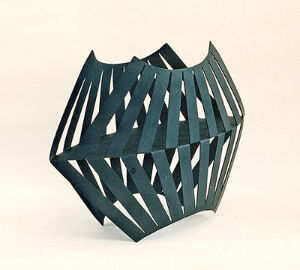Concretism
Concretism in Brazil
Concretism was an artistic and literary movement that emerged in the 1950s in Brazil, influenced by contemporary European currents such as Constructivism and Concretism. In literature, Concretism stood out for valuing form, structure, and language, seeking objectivity and rationality in the composition of texts.
In all artistic expressions, whether in visual arts, literature, or other art forms, Concretism was characterized by geometric abstraction, emphasis on simple forms, and precise organization of visual elements. Sacilotto—one of the main representatives of this movement in Brazil—is known for his works that explored geometry, color contrast, and abstract composition. He was also a pioneer in Brazilian concrete art, contributing significantly to the consolidation of the movement in the country. His works are marked by geometric precision, simplicity of forms, and the pursuit of a visual language free from superfluous elements.
In both literature and art, Concretism in Brazil represented a break from traditional forms of expression, valuing objectivity, rationality, and formal experimentation. Luiz Sacilotto is an emblematic example of this movement, and his legacy continues to influence artists and writers to this day.
The Concretism of Luiz Sacilotto
Initially, Sacilotto's works were figurative, but he gradually moved away from representing the world.
In 1955, he adopted the title Concreção for his works, followed by four numbers referring to the year and the sequence of execution. For example, the specific work Concreção 5629, created in 1956, marks Sacilotto's artistic maturity. This piece, composed of 38 black equilateral triangles on a white background on discarded aluminum plates, participated in the historic Exposição Nacional de Arte Concreta in 1956 at the São Paulo Museum of Modern Art.
The work reflects the principles of concrete art, such as the use of geometric shapes and repetition, standing out for the innovation in the material used by the artist.
![[i]Concreção 5629,[/i] 1956
Luiz Sacilotto
Synthetic enamel on aluminum, c.i.d.
60.00 cm x 80.00 cm
Collection of the Museum of Contemporary Art at the University of São Paulo
Source: Enciclopédia Itaú Cultural.](https://www.geogebra.org/resource/ddfvkkjk/uureHJhmLCBuWW1J/material-ddfvkkjk.png)
Concreção 5629 represents the moment when Luiz Sacilotto explores the three-dimensional aspect in his art. The use of aluminum as a support allowed for cuts and folds, transforming the 1956 piece into a relief. Although the technical details are not specified, the black triangles are slightly raised, standing 0.4 centimeters above the white surface of 60 x 80 cm. This subtle measurement alters the dynamics between the elements of the artwork and its relationship with the world. From this piece onwards, Sacilotto began to consider environmental variables such as light and shadow, suggesting that the work claims to be a presence in the world, not just a representation.
In the following year, 1957, the artist created his first sculptures in aluminum, iron, and brass, which eventually became public artworks. Through the voids in their structures, these sculptures and reliefs provide a new perspective for observing the world and interacting with space, marking a significant contribution from Sacilotto to the art world. In an interview with Nelson Aguilar, Sacilotto emphasized the importance of empty spaces, stating that they hold the same relevance as the filled spaces.
Interview with Nelson Aguilar
Sacilotto, the Worker Knowledge of Concretism
Folha de S.Paulo (Ilustrada) - April 20, 1988
[...]
And the sculptures? You work with hollow forms. The void has great importance. Air is a substantial part.
The void is a component. The origin, a large part of these sculptures comes from my proposal: within a flat surface, through cutting and folding, to transform the space.
[...]
Some sculptures titled Concreção, by Luiz Sacilotto
In the titles of Luiz Sacilotto's works, such as Concreção 5629, the numbers generally carry specific meanings beyond serving as unique identifiers for each piece within a series.
These numerical titles also reflect the objective and rational approach of Concretism, the artistic movement to which Sacilotto was associated. Instead of descriptive titles that suggest a specific interpretation of the work, the numerical titles maintain neutrality, leaving the visual interpretation of the piece to the observer.
Figure 10 - Concreção 5730
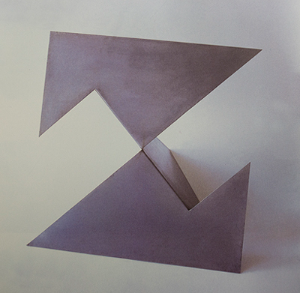
Figure 11 - Concreção, 1958
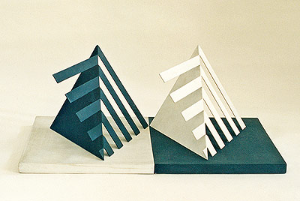
Figure 12 - Concreção 5839
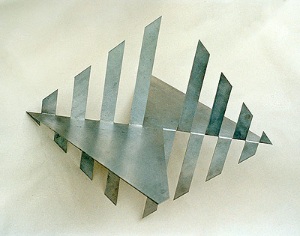
Figure 13 - Concreção 5840
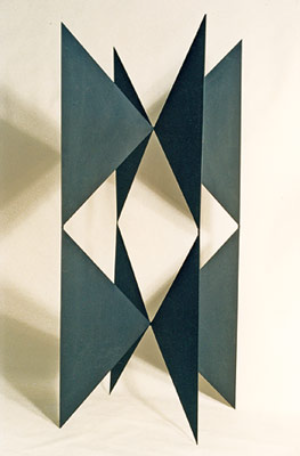
Figure 14 - Concreção, 1959
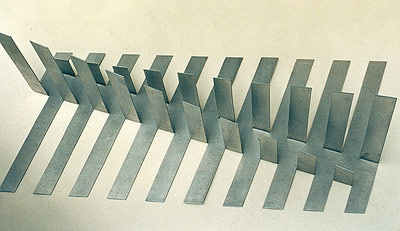
Figure 15 - Concreção 5941
